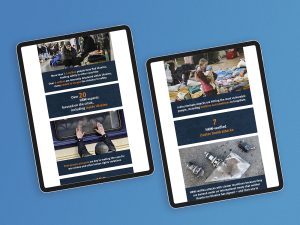The release of the Giving USA report has sparked conversations about the state of charitable giving, most pointedly focusing on a headline of declining giving from 2021 to 2022, from approximately $510 billion to $499 billion in current-dollar contributions.
As committed nonprofit advocates and fundraisers, we all hope for continued growth in philanthropy, so a loss of $11 billion (or $17 billion, when adjusted for inflation) is disheartening. After all, think of all the good those funds could do! But it’s crucial to dig deeper into the data to better understand the nuances of the current landscape and what this report can mean for nonprofit fundraising.
We’ve synthesized some top takeaways from our Faircom New York strategists – including shedding light on causes for concern and highlighting strategies and solutions for fellow fundraisers. By navigating challenges with agility and implementing targeted approaches, we are confident that nonprofits can continue to make a lasting impact through their programs, hand-in-hand with their valuable donor communities.
1. Gaining Perspective
While the decline in giving from 2021 to 2022 may seem alarming, it’s important to view it within a broader context. Nonprofit giving has historically shown resilience, with only a few drops in giving (in current dollars) over the past four decades. This most recent decline comes on the heels of surging donations during the Covid-19 pandemic, which we saw at the time as welcome but also unprecedented.
After this leap in American philanthropy, a correction in subsequent years is natural. That’s why looking at the trajectory over multiple years is so important. When we do so, we see that 2022 giving is second overall to only 2021 in current-dollar giving. That is remarkable! And, it is still in the “top five” most generous years when adjusting for historically high levels of inflation – on par with pre-pandemic totals in 2018 and 2019.
Of course, we’d love to see giving continue to grow without any setbacks – and, we’re not dismissing concerns raised by certain trends, which we’ll delve into shortly. However, it’s important to respond to the Giving USA headlines with a measured and balanced approach.
2. Understanding the Complexities of Individual Giving
Declining individual giving is among the most notable takeaways from Giving USA – with a 6.4% decrease from 2021, even as all other contribution sources (i.e., foundations, bequests, and corporations) grew in current dollars. Yet the picture is not so simple.
To fully grasp the dynamics of individual giving, we must acknowledge its increasing intricacy. The landscape has evolved, with alternative giving vehicles and private foundations assuming prominent roles. When we think of foundation giving, we tend to envision big-name funders like Ford, Rockefeller, Carnegie, and Gates. While they do make significant contributions and can drive the growing “slice” of foundation support in the giving pie, it’s crucial to recognize that many foundation grants are, in essence, individual contributions by another name.
That’s because approximately half of all foundation giving is driven by individuals. This includes grants made through family foundations or donor-advised funds (DAFs) directed by individuals at community foundations. Let’s consider an eye-opening statistic: A review by the National Philanthropic Trust revealed that DAF giving grew a staggering 630% over 15 years from 2007 to 2021 – 13 times faster than individual giving! This is alongside double-digit growth in foundation giving as tracked by Giving USA from 2020 to 2022. (Of note, not all DAF giving will be accounted for in foundation contributions, given the diversity of institutions hosting donor-advised funds.)
However, there is a bigger concern that deserves our attention regarding charitable support from individuals, namely the long-term trajectory of declining household participation in giving. Over the past decades, we’ve witnessed a steady decrease from around two-thirds of all households to less than half engaging in charitable giving. This is not a year-to-year change but a persistent trend that challenges us as nonprofit fundraisers to develop proactive approaches to reach still-engaged donors and reengage others who have fallen out of philanthropic habits. We are best served in this endeavor if we create strategies that respond to the increasingly complex economy of individual giving, across various vehicles.
3. Resilience Across Subsectors
While the year-to-year fluctuations may raise concerns, it’s noteworthy that six out of nine subsectors in the nonprofit sector have exceeded pre-pandemic giving levels. This resilience demonstrates the sector’s ability to bounce back and adapt. While short-term declines warrant attention, the overall trend indicates a robust and growing sector that continues to make important impacts.
Of particular note to our team was the significant jump in international giving in 2022 – a testament to the role that Americans play as global citizens. The continuing war in Ukraine has been a galvanizing cause to encourage generosity in support of those in crisis, and this showcases the compassion and empathy donors have in rising to the occasion when dramatic needs surface.
In addition, we noted the continuing realignment of giving priorities to pre-pandemic patterns. Sub-sectors like Arts, Culture, and Humanities, which had a decline in support during the height of the pandemic, are experiencing continued growth as we move away from that period. This shows the adaptability and breadth of the sector overall as giving priorities become more varied beyond urgent or crisis needs and donors move to support our communities in robust ways that speak to the diversity of the human experience.
4. Coming to Terms with the Challenges
As noted, there are real challenges, which we’ve already hinted at some above. Below we lay out three key areas that we think are particularly important to grapple with in 2023 and the years that follow.
- Donor Confidence is Declining: Philanthropy moves at the speed of trust, which is why we are particularly concerned by complementary reporting coming from Dunham + Company that showcases drops in donor confidence. Within this research, they found that one in four donors indicated their intention to reduce giving in 2023. While this doesn’t imply a complete cessation of donations, it underscores the importance of making a compelling case for support, targeting the right audience, and fostering authentic connections with donors – because trust and donor confidence will be more instrumental than ever in philanthropic decision making.
- Major Donor Giving Dips: For the first time in a decade, as shown in reporting from the Fundraising Effectiveness Project, major donor giving has experienced a decline. Each group considers their major gift audience slightly differently, so to put this in perspective, donors giving $500 to $5,000 declined 3.9% from 2021, donors giving $5,000-$50,000 declined 3.6%, and donors giving $50,000+ declined 4.6%. While part of this decline may again be attributed to a “Covid bump” correction, it will be important to consider strategies to engage with these segments in a meaningful way as well as strengthen pipelines to shore up future high-dollar giving, which is so valuable to ensuring steady nonprofit revenues.
- Household Participation in Giving is Down: This is not a new trend but an ongoing challenge that demands our attention. While the United States has traditionally held the position of the world’s leading philanthropic market, we must address the issue of Americans gradually disengaging from the habit of giving and philanthropy. To overcome this, we need to embrace creativity, adaptability, and responsiveness in our approaches to donors, particularly as human interaction and engagement with institutions are evolving in diverse and preference-specific ways. Nonprofits should internalize this lesson and incorporate it into their strategic planning and development efforts, creating meaningful and engaging communities that resonate with donors – thereby fostering a culture of active participation in philanthropy that reignites the spirit of giving within our society.
5. Strategic Responses
All is not lost! We hope the above reflections illustrate a balanced view of trends in the fundraising space highlighted through Giving USA so that we can be somber of the challenges in front of us but realistic about the true opportunities to continue driving change through nonprofit work.
In the coming year, we are prioritizing the following strategies and suggest our fellow fundraisers consider the same:
- Embracing targeted approaches and leveraging machine learning opportunities to identify potential donors effectively. We want to ensure we are reaching the most likely supporters in an increasingly tight market, both in terms of propensity to give and mission-alignment as well as capacity to make lasting contributions.
- Cultivating a sense of community and forging meaningful connections to foster long-lasting relationships, pipeline development, and donor loyalty. For donors currently in the mix, this is critical to ensuring they continue to find joy and purpose in their partnership with nonprofits! And, a vibrant community is also more appealing to draw in new supporters who want to join with like-minded individuals to create change.
- Harnessing loyalty-driven commitments like bequests to secure enduring support. Bequests continue to grow as another vehicle of individual giving, and while it is deferred revenue, it is critical to highlight these future giving opportunities to long-standing donor audiences. Successfully securing legacy commitments requires planting the seed well in advance and building trust with donors that nonprofits are a wise investment in the future.
- Prioritizing engagement with “stickier” donor audiences, such as sustainers, mid-level contributors, and major donors. If competition for individual audiences is growing, it is essential for nonprofits to build partnerships with donors who are more likely to be “in it for the long haul”. Retention rates across recurring supporters and comparatively higher-dollar audiences remain higher than annual fund-level segments, and the declines seen at the top end of the donor pyramid are still outpaced by individual giving audiences overall, indicating greater resilience. Developing tactics, tools, and strategies to secure and continue to effectively steward these groups can set nonprofits up for more assured revenues year to year.
- Promoting alternative giving vehicles, including expanding options for donors who prefer deferred giving strategies. As the individual giving space grows in complexity, nonprofits need to be prepared to meet donors with clear information about their abilities to accept alternative gifts, including direct appeals that promote these avenues of giving.
In Conclusion
The Giving USA report provides valuable insights into the current state of nonprofit giving, highlighting both challenges and opportunities for fundraisers. When there is a negative headline to grasp onto, it can be tempting to lean into a bleak picture and be driven by fear of what is to come – but by delving into the intricacies of the data and taking a more comprehensive view of the market, including a longer time lens, the ways in which nonprofits can adapt and thrive become clearer.
We encourage our colleagues in the sector to stay open-minded and recall the long-standing resilience of the nonprofit space in the face of adversity. While the landscape may be changing – as it is bound to evolve and take on new shape – we are confident in the ingenuity of nonprofit fundraisers to take strategic and thoughtful approaches to drive profound impact in their communities, inspire generosity, and drive positive change.
These are just our initial considerations as we weigh Giving USA findings in our future strategy development, but we would love to talk with you more about your thoughts, concerns, and plans for the future as well! Please feel free to reach out to our team to schedule a time to speak about how you can set up a strong roadmap for fundraising through 2023 and beyond. We look forward to connecting with you!




